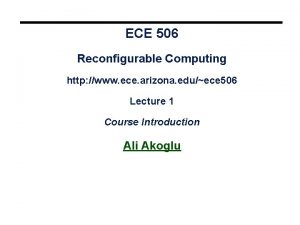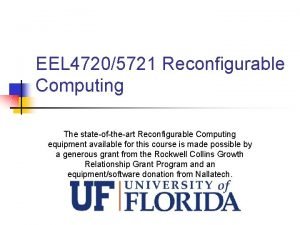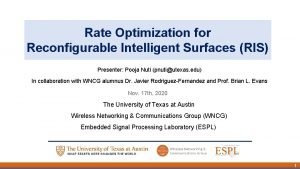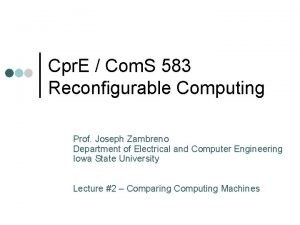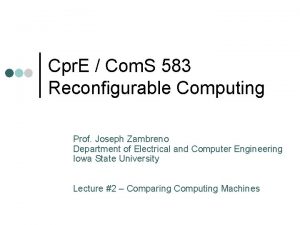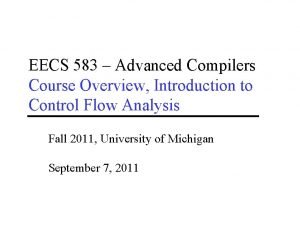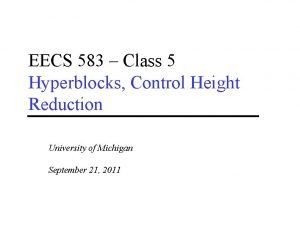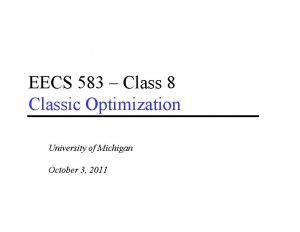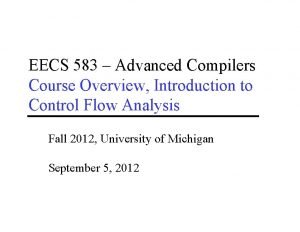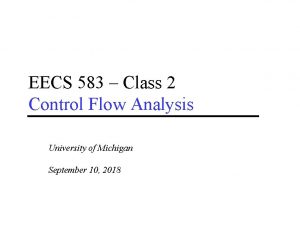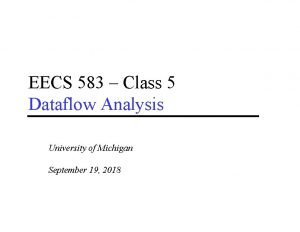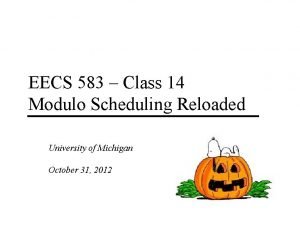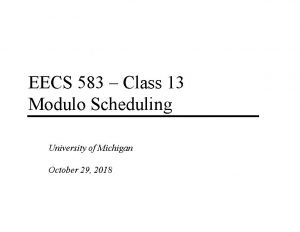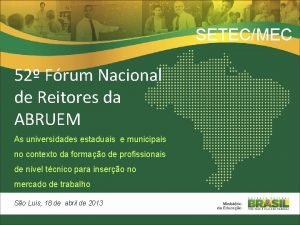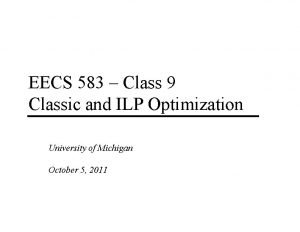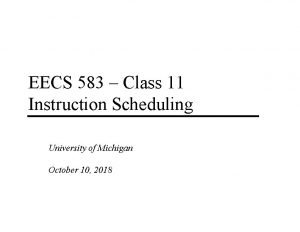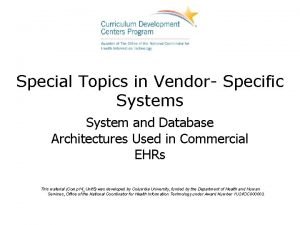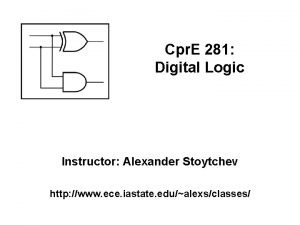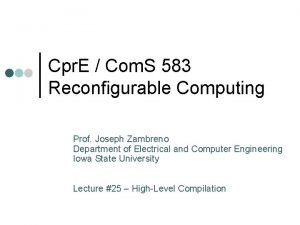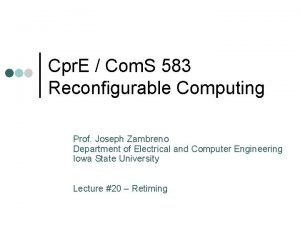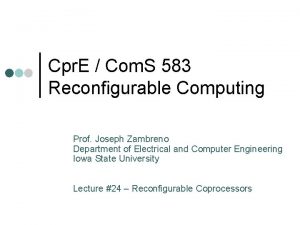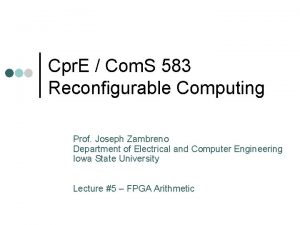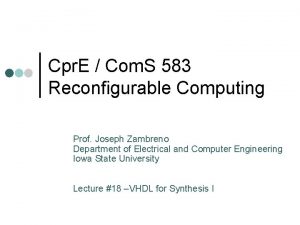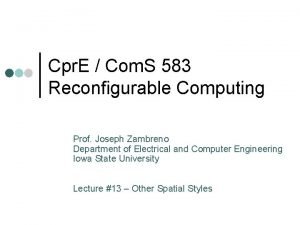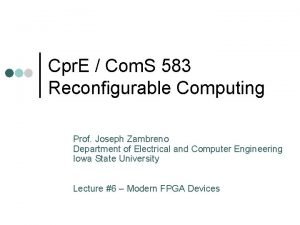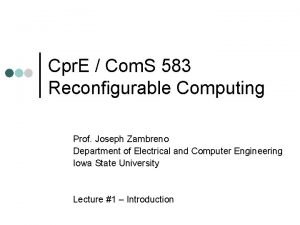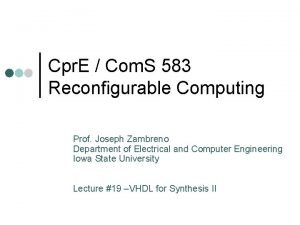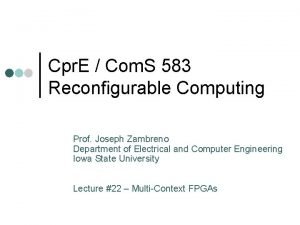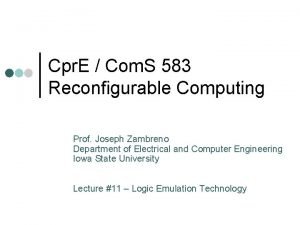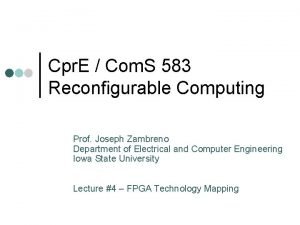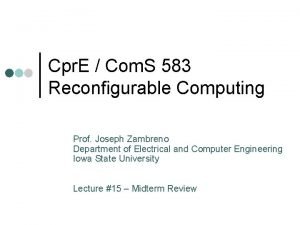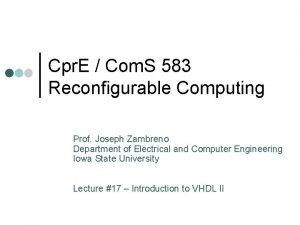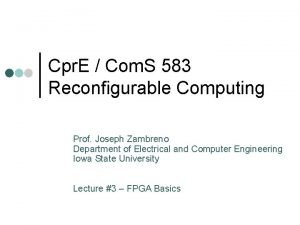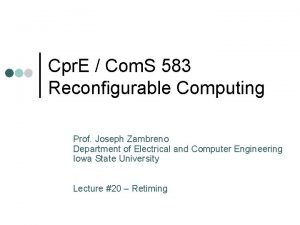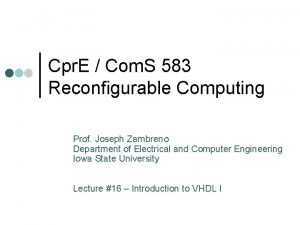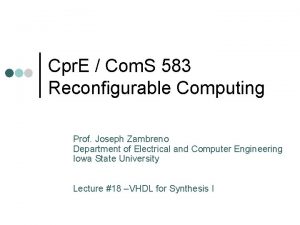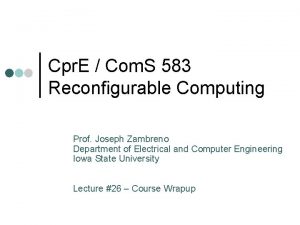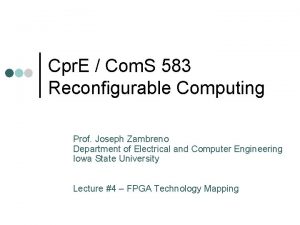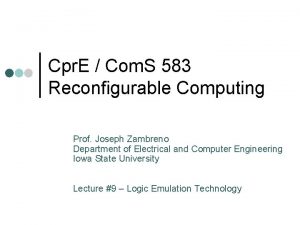Cpr E Com S 583 Reconfigurable Computing Prof

Cpr. E / Com. S 583 Reconfigurable Computing Prof. Joseph Zambreno Department of Electrical and Computer Engineering Iowa State University Lecture #22 – Multi-Context FPGAs

Recap – HW/SW Partitioning process (a, b, c) in port a, b; out port c; { read(a); … write(c); } Specification Partition Model Line () { a=… … detach } Interface FPGA Capture Synthesize Processor • Good partitioning mechanism: 1)Minimize communication across bus 2)Allows parallelism both hardware (FPGA) and processor operating concurrently 3)Near peak processor utilization at all times (performing useful work) November 7, 2006 Cpr. E 583 – Reconfigurable Computing Lect-22. 2

Recap – Communication and Control • Need to signal between CPU and accelerator • Data ready • Complete • Implementations: • Shared memory • FIFO • Handshake • If computation time is very predictable, a simpler communication scheme may be possible November 7, 2006 Cpr. E 583 – Reconfigurable Computing Lect-22. 3

Recap – System-Level Methodology Informal Specification, Constraints System model Performance evaluation Component profiling Architecture design HW/SW implementation Fail Test Prototype Success Implementation November 7, 2006 Cpr. E 583 – Reconfigurable Computing Lect-22. 4

Outline • Recap • Multicontext • Motivation • Cost analysis • Hardware support • Examples November 7, 2006 Cpr. E 583 – Reconfigurable Computing Lect-22. 5

Single Context • When we have • Cycles and no data parallelism • Low throughput, unstructured tasks • Dissimilar data dependent tasks • Active resources sit idle most of the time • Waste of resources • Why? November 7, 2006 Cpr. E 583 – Reconfigurable Computing Lect-22. 6

Single Context: Why? • Cannot reuse resources to perform different functions, only the same functions November 7, 2006 Cpr. E 583 – Reconfigurable Computing Lect-22. 7

Multiple-Context LUT • Configuration selects operation of computation unit • Context identifier changes over time to allow change in functionality • DPGA – Dynamically Programmable Gate Array November 7, 2006 Cpr. E 583 – Reconfigurable Computing Lect-22. 8

Computations that Benefit A B F 0 F 1 F 2 Non-pipelined example • Low throughput tasks • Data dependent operations • Effective if not all resources active simultaneously • Possible to time-multiplex both logic and routing resources November 7, 2006 Cpr. E 583 – Reconfigurable Computing Lect-22. 9

Computations that Benefit (cont. ) November 7, 2006 Cpr. E 583 – Reconfigurable Computing Lect-22. 10

Computations that Benefit (cont. ) November 7, 2006 Cpr. E 583 – Reconfigurable Computing Lect-22. 11

Resource Reuse • Resources must be directed to do different things at different times through instructions • Different local configurations can be thought of as instructions • Minimizing the number and size of instructions a key to successfully achieving efficient design • What are the implications for the hardware? November 7, 2006 Cpr. E 583 – Reconfigurable Computing Lect-22. 12

Example: ASCII – Binary Conversion • Input: ASCII Hex character • Output: Binary value signal input : std_logic_vector(7 downto 0); signal output : std_logic_vector(3 downto 0); process (input) begin end process; November 7, 2006 Cpr. E 583 – Reconfigurable Computing Lect-22. 13

ASCII – Binary Conversion Circuit November 7, 2006 Cpr. E 583 – Reconfigurable Computing Lect-22. 14

Implementation Choices Implementation #1 NA= 3 Implementation #2 NA= 4 • Both require same amount of execution time • Implementation #1 more resource efficient November 7, 2006 Cpr. E 583 – Reconfigurable Computing Lect-22. 15
![Previous Study [Deh 96 B] Interconnect Mux Logic Reuse • Actxt 80 Kl 2 Previous Study [Deh 96 B] Interconnect Mux Logic Reuse • Actxt 80 Kl 2](http://slidetodoc.com/presentation_image_h/25e5fa41961480c013de088568b070b2/image-16.jpg)
Previous Study [Deh 96 B] Interconnect Mux Logic Reuse • Actxt 80 Kl 2 * Each context not overly costly • dense encoding • Abase 800 Kl 2 compared to base cost of wire, switches, IO circuitry Question: How does this effect scale? November 7, 2006 Cpr. E 583 – Reconfigurable Computing Lect-22. 16

DPGA Prototype November 7, 2006 Cpr. E 583 – Reconfigurable Computing Lect-22. 17

Multicontext Tradeoff Curves • • • Assume ideal packing: Nactive = Ntotal/L Reminder: c*Actxt = Abase Difficult to exactly balance resources/demands Needs for contexts may vary across applications Robust point where critical path length equals # contexts November 7, 2006 Cpr. E 583 – Reconfigurable Computing Lect-22. 18

In Practice • Scheduling limitations • Retiming limitations November 7, 2006 Cpr. E 583 – Reconfigurable Computing Lect-22. 19

Scheduling Limitations • NA (active) • Size of largest stage • Precedence: • Can evaluate a LUT only after predecessors have been evaluated • Cannot always, completely equalize stage requirements November 7, 2006 Cpr. E 583 – Reconfigurable Computing Lect-22. 20

Scheduling • Precedence limits packing freedom • Freedom shows up as slack in network November 7, 2006 Cpr. E 583 – Reconfigurable Computing Lect-22. 21

Scheduling • Computing Slack: • ASAP (As Soon As Possible) Schedule • propagate depth forward from primary inputs • depth = 1 + max input depth • ALAP (As Late As Possible) Schedule • propagate distance from outputs back from outputs • level = 1 + max output consumption level • Slack • slack = L+1 -(depth+level) [PI depth=0, PO level=0] November 7, 2006 Cpr. E 583 – Reconfigurable Computing Lect-22. 22

Allowable Schedules Active LUTs (NA) = 3 November 7, 2006 Cpr. E 583 – Reconfigurable Computing Lect-22. 23

Sequentialization • Adding time slots • More sequential (more latency) • Adds slack • Allows better balance L=4 NA=2 (4 or 3 contexts) November 7, 2006 Cpr. E 583 – Reconfigurable Computing Lect-22. 24

Multicontext Scheduling • “Retiming” for multicontext • goal: minimize peak resource requirements • NP-complete • List schedule, anneal • How do we accommodate intermediate data? • Effects? November 7, 2006 Cpr. E 583 – Reconfigurable Computing Lect-22. 25

Signal Retiming • Non-pipelined • hold value on LUT Output (wire) • from production through consumption • Wastes wire and switches by occupying • For entire critical path delay L • Not just for 1/L’th of cycle takes to cross wire segment • How will it show up in multicontext? November 7, 2006 Cpr. E 583 – Reconfigurable Computing Lect-22. 26

Signal Retiming • Multicontext equivalent • Need LUT to hold value for each intermediate context November 7, 2006 Cpr. E 583 – Reconfigurable Computing Lect-22. 27

Full ASCII Hex Circuit • Logically three levels of dependence • Single Context: 21 LUTs @ 880 Kl 2=18. 5 Ml 2 November 7, 2006 Cpr. E 583 – Reconfigurable Computing Lect-22. 28

Multicontext Version • Three contexts: 12 LUTs @ 1040 Kl 2=12. 5 Ml 2 • Pipelining needed for dependent paths November 7, 2006 Cpr. E 583 – Reconfigurable Computing Lect-22. 29

ASCII Hex Example • All retiming on wires (active outputs) • Saturation based on inputs to largest stage • With enough contexts only one LUT needed • Increased LUT area due to additional stored configuration information • Eventually additional interconnect savings taken up by LUT configuration overhead Ideal Perfect scheduling spread + no retime overhead November 7, 2006 Cpr. E 583 – Reconfigurable Computing Lect-22. 30

ASCII Hex Example (cont. ) @ depth=4, c=6: 5. 5 Ml 2 (compare 18. 5 Ml 2 ) November 7, 2006 Cpr. E 583 – Reconfigurable Computing Lect-22. 31

General Throughput Mapping • If only want to achieve limited throughput • Target produce new result every t cycles • Spatially pipeline every t stages • cycle = t • Retime to minimize register requirements • Multicontext evaluation w/in a spatial stage • Retime (list schedule) to minimize resource usage • Map for depth (i) and contexts (c) November 7, 2006 Cpr. E 583 – Reconfigurable Computing Lect-22. 32

Benchmark Set • 23 MCNC circuits • Area mapped with SIS and Chortle November 7, 2006 Cpr. E 583 – Reconfigurable Computing Lect-22. 33

Area v. Throughput November 7, 2006 Cpr. E 583 – Reconfigurable Computing Lect-22. 34

Area v. Throughput (cont. ) November 7, 2006 Cpr. E 583 – Reconfigurable Computing Lect-22. 35

Reconfiguration for Fault Tolerance • Embedded systems require high reliability in the presence of transient or permanent faults • FPGAs contain substantial redundancy • Possible to dynamically “configure around” problem areas • Numerous on-line and off-line solutions November 7, 2006 Cpr. E 583 – Reconfigurable Computing Lect-22. 36

Column Based Reconfiguration • Huang and Mc. Cluskey • Assume that each FPGA column is equivalent in terms of logic and routing • Preserve empty columns for future use • Somewhat wasteful • Precompile and compress differences in bitstreams November 7, 2006 Cpr. E 583 – Reconfigurable Computing Lect-22. 37

Column Based Reconfiguration • Create multiple copies of the same design with different unused columns • Only requires different inter-block connections • Can lead to unreasonable configuration count November 7, 2006 Cpr. E 583 – Reconfigurable Computing Lect-22. 38

Column Based Reconfiguration • Determining differences and compressing the results leads to “reasonable” overhead • Scalability and fault diagnosis are issues November 7, 2006 Cpr. E 583 – Reconfigurable Computing Lect-22. 39

Summary • In many cases cannot profitably reuse logic at device cycle rate • Cycles, no data parallelism • Low throughput, unstructured • Dissimilar data dependent computations • These cases benefit from having more than one instructions/operations per active element • Economical retiming becomes important here to achieve active LUT reduction • For c=[4, 8], I=[4, 6] automatically mapped designs are 1/2 to 1/3 single context size November 7, 2006 Cpr. E 583 – Reconfigurable Computing Lect-22. 40
- Slides: 40
